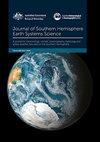Global-scale future climate projections from ACCESS model contributions to CMIP6
IF 3.6
4区 地球科学
Q1 Earth and Planetary Sciences
引用次数: 0
Abstract
This paper describes projected climate evolution and outcomes simulated by the Australian Community Climate and Earth System Simulator (ACCESS) to varying future scenarios, including of socio-ecological and technological development, and land-use and land-cover change. Contributions to the Coupled Model Intercomparison Project Phase 6 (CMIP6) from the climate model version, ACCESS-CM2, and the fully coupled Earth System Model version, ACCESS-ESM1.5, are presented for the near-future (2020–2050), 21st Century (2000–2100) and longer-term (2100–2300). Scenario differentiation in the near future is aided by high-density sampling in large-ensemble ACCESS-ESM1.5, more clearly illustrating projected 2020–2050 global changes in temperature, precipitation and aerosol optical depth. Over the 21st Century, the heightened equilibrium climate sensitivity of ACCESS-CM2 relative to ACCESS-ESM1.5 results in persistently greater surface air temperature increases and larger amplified polar warming, leading to more rapid sea ice decline. Although weakening of the Atlantic meridional overturning circulation (AMOC) occurs in both models, 21st Century recovery under aggressive-mitigation and overshoot scenarios only occurs in ACCESS-ESM1.5; AMOC weakening continues under all scenarios in ACCESS-CM2 through to 2100. Longer-term climate response from simulations extending to 2300 depict opposing hemispheric responses of polar surface air temperatures and sea ice in both models under scenarios based on aggressive mitigation action, leading to a resurgence of surface ocean warming and Antarctic sea ice decline. Under a future scenario where development is driven by continued fossil fuel use, both AMOC and Antarctic Bottom Water Formation continue to weaken across 2200–2300 in both models, reaching such low levels in ACCESS-CM2 that these pivotal components of global meridional overturning circulation could be considered essentially to have ceased.从 ACCESS 模型对 CMIP6 的贡献中预测全球未来气候
本文介绍了澳大利亚社区气候和地球系统模拟器(ACCESS)根据不同的未来情景(包括社会生态和技术发展以及土地利用和土地覆盖物变化)模拟的预计气候演变和结果。本文介绍了气候模式 ACCESS-CM2 和完全耦合地球系统模式 ACCESS-ESM1.5 在近期(2020-2050 年)、21 世纪(2000-2100 年)和长期(2100-2300 年)对耦合模式相互比较项目第 6 阶段(CMIP6)的贡献。大集合 ACCESS-ESM1.5 中的高密度采样有助于区分近期情景,更清晰地说明了 2020-2050 年全球温度、降水和气溶胶光学深度的预计变化。在 21 世纪,ACCESS-CM2 相对于 ACCESS-ESM1.5 的平衡气候敏感性提高,导致地表气温持续升高,极地变暖幅度扩大,海冰减少速度加快。虽然大西洋经向翻转环流(AMOC)的减弱在两个模式中都有发生,但在积极减缓和超调情景下的 21 世纪恢复只发生在 ACCESS-ESM1.5 中;而在 ACCESS-CM2 中,在所有情景下,大西洋经向翻转环流的减弱一直持续到 2100 年。在基于积极减缓行动的情景下,两种模式下延伸到 2300 年的模拟结果显示,两极表层气温和海冰的半球反应截然相反,导致表层海洋变暖和南极海冰减少。在继续使用化石燃料推动发展的未来情景下,两个模式中的 AMOC 和南极底层水形成在 2200-2300 年期间继续减弱,在 ACCESS-CM2 中达到如此低的水平,以至于可以认为全球经向翻转环流的这些关键组成部分基本上已经停止。
本文章由计算机程序翻译,如有差异,请以英文原文为准。
求助全文
约1分钟内获得全文
求助全文
来源期刊

Journal of Southern Hemisphere Earth Systems Science
Earth and Planetary Sciences-Oceanography
CiteScore
8.10
自引率
8.30%
发文量
0
审稿时长
>12 weeks
期刊介绍:
The Journal of Southern Hemisphere Earth Systems Science (JSHESS) publishes broad areas of research with a distinct emphasis on the Southern Hemisphere. The scope of the Journal encompasses the study of the mean state, variability and change of the atmosphere, oceans, and land surface, including the cryosphere, from hemispheric to regional scales.
general circulation of the atmosphere and oceans,
climate change and variability ,
climate impacts,
climate modelling ,
past change in the climate system including palaeoclimate variability,
atmospheric dynamics,
synoptic meteorology,
mesoscale meteorology and severe weather,
tropical meteorology,
observation systems,
remote sensing of atmospheric, oceanic and land surface processes,
weather, climate and ocean prediction,
atmospheric and oceanic composition and chemistry,
physical oceanography,
air‐sea interactions,
coastal zone processes,
hydrology,
cryosphere‐atmosphere interactions,
land surface‐atmosphere interactions,
space weather, including impacts and mitigation on technology,
ionospheric, magnetospheric, auroral and space physics,
data assimilation applied to the above subject areas .
Authors are encouraged to contact the Editor for specific advice on whether the subject matter of a proposed submission is appropriate for the Journal of Southern Hemisphere Earth Systems Science.
文献相关原料
| 公司名称 | 产品信息 | 采购帮参考价格 |
|---|
 求助内容:
求助内容: 应助结果提醒方式:
应助结果提醒方式:


